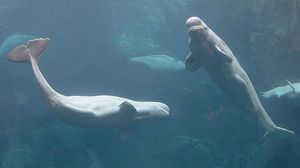Dolphins Whales and Porpoises: Cetacea
Physical Characteristics

Cetaceans (sih-TAY-shunz) are whales, dolphins, and porpoises. These mammals live, eat, reproduce, and rest in the water. They range in size from that of a small human—5 feet (1.5 meters) and 110 pounds (50 kilograms)—to huge, building-sized animals of 110 feet (33 meters) and 400,000 pounds (180,000 kilograms). Their ancestors were land mammals. More than fifty million years ago, these ancestors evolved physical characteristics that allowed them to live successfully in the water. Today scientists believe that the closest living land-based relative of whales, dolphins, and porpoises is the hippopotamus.
All cetaceans share certain physical characteristics that allow them to live their entire life in the water. Most notably, they all have streamlined, smooth, bodies to cut down on friction and turbulence as they move through the water. This streamlining has come about because the bones in their front legs are shortened and compressed to form paddles called flippers that have no fingers or claws. In addition, their back legs are so reduced that all that remains are a few internal pelvic bones. Likewise, they have no external reproductive organs. Male cetaceans have a retractable penis, which means that they can draw it up inside their body. The nipples of the female are also hidden in a slit within their belly.
The need to be streamlined has affected the shape of the skull and the sense organs found it in. The bones of the skull and the jawbones have become elongated, stretched out. The nostrils, usually on the front of the face in land mammals, have moved to the top of the head and are called blowholes. There can be one or two blowholes, depending on species, or a single slit on the top of the head. Blowholes are connected to the lungs and can be closed to keep out water when the animal dives.
Cetaceans have no external, outside, ears, although they have very good hearing. Sound is transmitted to the internal ear through bones. Most members of this order have good eyesight, although some species that live in cloudy water have lost most of the ability to see. Cetaceans use a complex system of communication and are thought to be highly intelligent. They have large brains in proportion to their body size.
All members of this order are hairless, they may have a few hairs at birth, but have a thick layer of oil and fat called blubber under the skin. They are warm-blooded; their core body temperature stays about the same as that of a human, even in cold Arctic waters. Cetaceans have no sweat glands. They regulate their temperature by controlling the amount of blood flowing through their flippers and fins, which are not covered with blubber.
Members of this order are known for their ability to make deep dives and remain underwater for long periods. Sperm whales have been known to dive more than 6,080 feet (1,853 meters). They have an efficient circulatory system that allows them to store and retrieve large amounts of oxygen in their blood and muscle tissue. In addition, when they dive, they reduce blood flow to their skeletal muscles, decreasing oxygen use in the muscles while keeping blood flow to the brain. Finally, when they dive, they expel, push out, the air in their lungs. Reducing the amount of air in the lungs helps them withstand the high pressure that occurs when they dive deeply.
Although all cetaceans have common characteristics that suit them to life in the water, different species have evolved physical and behavioral features that allow them to eat certain foods or inhabit specific zones. There are two suborders of whales, each with identifying physically characteristics. Mysticeti are the baleen (buh-LEEN or BAY-leen) whales. These whales have no teeth. To feed, they filter large amounts of water through flexible plates in their mouth called baleen. The baleen strains out krill, small shrimp and plankton, which they collect with their tongue and swallow. This suborder includes the largest whales on Earth.
Odontoceti, the other suborder of whales, all have teeth that they use to catch fish, squid, octopus, and marine mammals such as seals, dolphins, and other whales. They are often referred to as toothed whales to distinguish them from baleen whales. These whales use echolocation (eck-oh-loh-KAY-shun) to navigate and find prey. Echolocation involves making sounds that bounce off objects. Sense organs pick up the echo or reflected sound and use the timing, direction, and strength of the echo in order to locate objects. In some species, echolocation is so sensitive that it can locate an object less than 0.5 inches across (1.25 centimeters) at a distance of 50 feet (15 meters). Unlike toothed whales, baleen whales do not have a highly developed sense of echolocation.
This order also contains porpoises and dolphins. These animals are smaller than most whales, and some dolphins and porpoises live in fresh water rivers rather than in salt water. Strictly speaking, porpoises belong to only one family and are distinguished by their spade-shaped teeth. However, casual language makes little distinction between the terms porpoise and dolphin.
Additional topics
Animal Life ResourceMammalsDolphins Whales and Porpoises: Cetacea - Physical Characteristics, Behavior And Reproduction, Cetaceans And People, Conservation Status - GEOGRAPHIC RANGE, HABITAT, DIET